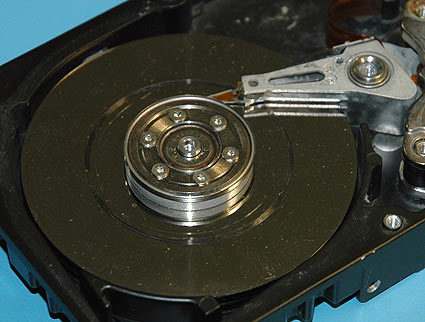Understanding Hard Drive Performance
Hard Drive Internals
This is a hard drive without the top cover that seals the inside of the drive to prevent intrusion of dust particles that can damage the sensitive read/write heads. This particular model is broken, as you might have already guessed from the circular impression, which is the result of a substantial head crash.
Hard drives are based on one or more magnetic platters that hold concentric tracks. These are filled from the outside to the inside, storing bits by magnetically aligning elements. Tracks located on top of each other on different platters are collectively called a cylinder. A movable arm is used to position the read/write heads on top of the platter. If there are several platters, the arm is more like a comb that fits between the platters. The arm/comb moves in a manner similar to that of a record player, so the heads can reach the inner and the outer areas of the platters. Both the top and the bottom of a platter are used to store data.
Bits are organized in so-called sectors, which are combined into allocation units (clusters). A cluster is the smallest chunk of data to store data. Depending on the file system (Windows uses NTFS or FAT32) the cluster size may vary The larger a cluster, the better is the overall sequential throughput, but you will end up wasting storage capacity if the average file size is much smaller than the cluster size.
Form Factors And Height
The most obvious difference between hard drives is their form factor, which is based on the platter diameter. Hard drives for desktop computers use 3.5" platters, while mobile hard drives use a diameter of 2.5". Enterprise hard drives may look like 3.5" models, but they actually use smaller platter diameters to enable higher rotation speeds. Hard drives for ultra-portable devices have platter diameters of only 1.8", and there are various micro hard drives with only 1" and 0.8" platters as well.
Hard drives in the 3.5" form factor typically have a height of 1", which is sufficient to accommodate up to five platters inside the drive. Notebook hard drives use single or twin platter designs and adhere to 9.5 mm or 12.5 mm height limits, though the latter isn't suitable for most notebook designs. If you look at 1" and 0.8" hard drives you'll notice a tendency towards proprietary solutions and heights, because there products are often optimized for certain customer requirements.
More platters certainly yields a higher storage capacity, because the total capacity is calculated by multiplying the per-platter capacity with the number of platters. For example, a data density of 160 GB per platter allows manufacturers to reach 640 GB capacity per drive with four platters. However, more platters also mean more read/write heads, which increases the risk of hardware failure due to the larger number of moving parts. Friction and energy requirements increase as well. In terms of price, one high capacity drive is still less expensive than multiple smaller ones. The only exception is high performance RAID arrays in servers, which intentionally run more hard drives to increase performance.
Get Tom's Hardware's best news and in-depth reviews, straight to your inbox.
Current page: Hard Drive Internals
Prev Page A Guide To Hard Drive Selection Next Page Storage Density, Recording Technology
Patrick Schmid was the editor-in-chief for Tom's Hardware from 2005 to 2006. He wrote numerous articles on a wide range of hardware topics, including storage, CPUs, and system builds.
-
darkfall13 They were comparing the minute differences or in this case indifferences within a range of nearly identical hard drives. Branding really didn't matter except to just have them all the same...Reply
